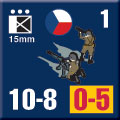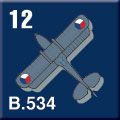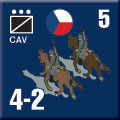Peace in Our Time:
Scenario Preview, Part One
by Mike Bennighof, Ph.D.
December 2021
 Back when I first designed the game system that became Panzer Grenadier, my teenaged self made up a list of games and expansion sets I hoped to publish for it, someday. That list included one featuring the stillborn German invasion of Czechoslovakia in the fall of 1938. Back when I first designed the game system that became Panzer Grenadier, my teenaged self made up a list of games and expansion sets I hoped to publish for it, someday. That list included one featuring the stillborn German invasion of Czechoslovakia in the fall of 1938.
Panzer Grenadier: Peace in Our Time could easily have become a printed, published expansion book, and it probably should have been: we have published games/books on stranger topics. But I wanted our Gold Club to have first-rate presents this holiday season, and so Peace in Our Time became a free download, with 176 new pieces and 10 new scenarios.
So let’s look at the first chapter:
Scenario One
Austrian Border
28 September 1939
 German plans called for the 14th Army, commanded by Wilhelm List, to advance from formerly Austrian territory northward toward the arms manufacturing center of Brno. The Czech Fourth Army barred the way, but lacked the pre-war border fortifications guarding the approaches from Germany – the Czechs had not anticipated that Germany might first occupy Austria before turning against them. Instead, the Czechs would have to rely on what positions they could rapidly put into place before the deluge began. German plans called for the 14th Army, commanded by Wilhelm List, to advance from formerly Austrian territory northward toward the arms manufacturing center of Brno. The Czech Fourth Army barred the way, but lacked the pre-war border fortifications guarding the approaches from Germany – the Czechs had not anticipated that Germany might first occupy Austria before turning against them. Instead, the Czechs would have to rely on what positions they could rapidly put into place before the deluge began.
Conclusion
 The Czech Army had been built to resist a German invasion behind fixed fortifications – most of its “divisions” were garrison units lacking mobility but in theory making up for that with firepower. Along the border with Austria, the Czechs had not invested in the heavy concrete and steel fortresses that lined the border with German Silesia to the north. That would give even a lightweight formation like one of the 1938 panzer divisions – which were placed in the first echelon, rather than held back for exploitation – a chance to smash its way through. The Czech Army had been built to resist a German invasion behind fixed fortifications – most of its “divisions” were garrison units lacking mobility but in theory making up for that with firepower. Along the border with Austria, the Czechs had not invested in the heavy concrete and steel fortresses that lined the border with German Silesia to the north. That would give even a lightweight formation like one of the 1938 panzer divisions – which were placed in the first echelon, rather than held back for exploitation – a chance to smash its way through.
Notes
 We start off with a German tank-led attack on Czech prepared positions. The Czechs don’t have the elaborate fortifications that screen other parts of the border, but they’ve dug themselves in and deployed their plentiful 37mm and 47mm anti-tank guns. Those weapons aren’t much in the usual Panzer Grenadier scenarios, but in 1938 the Germans have nothing better than the Panzer II light tank. The Czech guns are more than adequate to that challenge. We start off with a German tank-led attack on Czech prepared positions. The Czechs don’t have the elaborate fortifications that screen other parts of the border, but they’ve dug themselves in and deployed their plentiful 37mm and 47mm anti-tank guns. Those weapons aren’t much in the usual Panzer Grenadier scenarios, but in 1938 the Germans have nothing better than the Panzer II light tank. The Czech guns are more than adequate to that challenge.
Scenario Two
Vienna Panzers
29 September 1938
 After breaking through the Czech border forces, the Germans would try to drive northward to capture Brno and then advance into Moravia to meet the Second Army’s forces pushing southward from Silesia. Aware that fortifications can be penetrated by an enemy willing to accept the losses, the Czech plan included reserves poised to counter-attack any Germans who broke through the front. They did not expect the Germans to break through so fast. After breaking through the Czech border forces, the Germans would try to drive northward to capture Brno and then advance into Moravia to meet the Second Army’s forces pushing southward from Silesia. Aware that fortifications can be penetrated by an enemy willing to accept the losses, the Czech plan included reserves poised to counter-attack any Germans who broke through the front. They did not expect the Germans to break through so fast.
Conclusion
 Fourth Fast Division had been bulked up just before the German attack with two additional tank battalions. All three of its battalions together fielded 113 LT34 and LT35 light tanks, each of them individually superior to anything in the German order of battle. The 2nd Panzer Division still operated the useless Panzer I and Panzer II light tanks, the mainstay of the German Armored Forces in 1938. Fourth Fast Division had been bulked up just before the German attack with two additional tank battalions. All three of its battalions together fielded 113 LT34 and LT35 light tanks, each of them individually superior to anything in the German order of battle. The 2nd Panzer Division still operated the useless Panzer I and Panzer II light tanks, the mainstay of the German Armored Forces in 1938.
Notes
 It’s tank battle time, and the Germans are not going to be happy about that. The Czechs may just have light tanks, but they have 37mm guns on them. The German light tanks are much lighter, and only some of them have even a chance of hurting the Czech machines. That company of motorized 37mm guns might be more valuable to the German player than all of those tanks. It’s tank battle time, and the Germans are not going to be happy about that. The Czechs may just have light tanks, but they have 37mm guns on them. The German light tanks are much lighter, and only some of them have even a chance of hurting the Czech machines. That company of motorized 37mm guns might be more valuable to the German player than all of those tanks.
Scenario Three
Harvest of Shame
28 September 1939
 On the German Fourteenth Army’s left (western) flank, the 2nd Mountain Division would cross the river Thaya (Dyje in Czech) into the thick woods of the Thayatal (or Podyji). The “German” division had been formed that summer from former units of the Austrian Federal Army, and remained understrength in most areas, notably artillery and vehicles. The Czechs had not expected the Germans to be foolish enough to attack in this sector, but covered it with a border garrison anyway. On the German Fourteenth Army’s left (western) flank, the 2nd Mountain Division would cross the river Thaya (Dyje in Czech) into the thick woods of the Thayatal (or Podyji). The “German” division had been formed that summer from former units of the Austrian Federal Army, and remained understrength in most areas, notably artillery and vehicles. The Czechs had not expected the Germans to be foolish enough to attack in this sector, but covered it with a border garrison anyway.
Conclusion
 The Czech border battalions, organized into division-sized groups, were designed for independent action with their own engineer, mortar and anti-tank elements. On a map devoid of terrain, the advance west of Znojmo (Znaim) probably made a certain amount of sense. But this was no place to conduct blitzkrieg, especially with troops who had been preparing to fight the Germans just seven months previously and had been given a mostly-new slate of officers. The Czech border battalions, organized into division-sized groups, were designed for independent action with their own engineer, mortar and anti-tank elements. On a map devoid of terrain, the advance west of Znojmo (Znaim) probably made a certain amount of sense. But this was no place to conduct blitzkrieg, especially with troops who had been preparing to fight the Germans just seven months previously and had been given a mostly-new slate of officers.
Notes
 Newly-German mountain troops go over the river and through the woods toward Znjomo. Or maybe they don’t; the Czechs have one of their well-armed border battalions in the way. It’s going to be an infantry fight in dense terrain, and an excuse to use the Czech super-heavy machine guns. Newly-German mountain troops go over the river and through the woods toward Znjomo. Or maybe they don’t; the Czechs have one of their well-armed border battalions in the way. It’s going to be an infantry fight in dense terrain, and an excuse to use the Czech super-heavy machine guns.
Scenario Four
Rapid Response
29 September 1939
 The Czech Fast Divisions, like those in most Eastern European armies of the 1930’s, tried to blend all forms of mobile units in one formation: horse, motorized and mechanized. In practice those of other nations ended up operating those elements separately, and that probably would have happened to the Czechs as well. The 4th Fast Division’s 4th Cavalry Brigade had two cavalry regiments, a bicycle battalion and its own horse artillery battalion, and as such was a substantial force all on its own. The Czech Fast Divisions, like those in most Eastern European armies of the 1930’s, tried to blend all forms of mobile units in one formation: horse, motorized and mechanized. In practice those of other nations ended up operating those elements separately, and that probably would have happened to the Czechs as well. The 4th Fast Division’s 4th Cavalry Brigade had two cavalry regiments, a bicycle battalion and its own horse artillery battalion, and as such was a substantial force all on its own.
Conclusion
 The Czech fast divisions were organized to allow their two brigades to operate separately, with their own artillery battalions; the division supplied recon, anti-tank, anti-aircraft and engineer elements. Held back as a counter-attack reserve, these well-armed and well-trained formations would be responsible for stopping the German advance into Czech territory. Against the rapidly-organized new German divisions spearheading the invasion, their chances looked good. The Czech fast divisions were organized to allow their two brigades to operate separately, with their own artillery battalions; the division supplied recon, anti-tank, anti-aircraft and engineer elements. Held back as a counter-attack reserve, these well-armed and well-trained formations would be responsible for stopping the German advance into Czech territory. Against the rapidly-organized new German divisions spearheading the invasion, their chances looked good.
Notes
 It doesn’t get any easier for the mountaineers; once they get out of the woods, they’re hit by a counter-attack from Czech cavalry. The Czechs have firepower and mobility on their side; morale, leadership and initiative are about even. The tactical aspect of this war that never happened would not have been a German rollover. It doesn’t get any easier for the mountaineers; once they get out of the woods, they’re hit by a counter-attack from Czech cavalry. The Czechs have firepower and mobility on their side; morale, leadership and initiative are about even. The tactical aspect of this war that never happened would not have been a German rollover.
Scenario Five
Fast Divisions
30 September 1939
 In the center of 14th Army’s advance, the German 4th Light Division was to protect the right flank of the advance on Brno. Having stuffed the 2nd Panzer Division on the advance’s left flank, the Czech 4th Fast Division crossed behind the 2nd Border Group’s blocking positions to strike the advancing Germans head-on. The 4th Light Division, formerly the Austrian Federal Army’s Fast Division, had only been formed in April. In the center of 14th Army’s advance, the German 4th Light Division was to protect the right flank of the advance on Brno. Having stuffed the 2nd Panzer Division on the advance’s left flank, the Czech 4th Fast Division crossed behind the 2nd Border Group’s blocking positions to strike the advancing Germans head-on. The 4th Light Division, formerly the Austrian Federal Army’s Fast Division, had only been formed in April.
Conclusion
 While the fast divisions of both armies had their origin in the cavalry branch, only the Czech version retained horsed regiments. The German light divisions affected cavalry nomenclature, but their “cavalry” was mounted in trucks. While that gave the Germans a substantial advantage on the battlefield, the Czech division had a battalion of actual tanks instead of the worthless vehicles wielded by the German light division – and the 4th Light Division supporting 2nd Army had three such battalions. While the fast divisions of both armies had their origin in the cavalry branch, only the Czech version retained horsed regiments. The German light divisions affected cavalry nomenclature, but their “cavalry” was mounted in trucks. While that gave the Germans a substantial advantage on the battlefield, the Czech division had a battalion of actual tanks instead of the worthless vehicles wielded by the German light division – and the 4th Light Division supporting 2nd Army had three such battalions.
Notes
 I had to do it: a division-scale Panzer Grenadier battle. A Czech fast division meets its German equivalent, a light division, head-on. The Germans have the edge in motorized mobility, but the Czech have all of those tanks. You’ll have to make a few extra Czechs, but in exchange you get to fight with a whole division’s worth. I’m not sure if this is the largest scenario in all of Panzer Grenadier, but it’s pretty close if it’s not. I had to do it: a division-scale Panzer Grenadier battle. A Czech fast division meets its German equivalent, a light division, head-on. The Germans have the edge in motorized mobility, but the Czech have all of those tanks. You’ll have to make a few extra Czechs, but in exchange you get to fight with a whole division’s worth. I’m not sure if this is the largest scenario in all of Panzer Grenadier, but it’s pretty close if it’s not.
And that’s Chapter One. Next time, it’s Chapter Two.
Want if for yourself? Click right here to join the Gold Club.
Sign up for our newsletter right here. Your info will never be sold or transferred; we'll just use it to update you on new games and new offers.
Mike Bennighof is president of Avalanche Press and holds a doctorate in history from Emory University. A Fulbright Scholar and NASA Journalist in Space finalist, he has published a great many books, games and articles on historical subjects; people are saying that some of them are actually good.
He lives in Birmingham, Alabama with his wife, three children, and his Iron Dog, Leopold.
Want to keep Daily Content free of third-party ads? You can send us some love (and cash) through this link right here.
|
